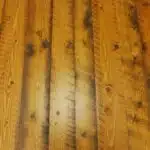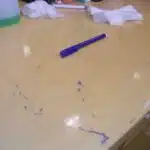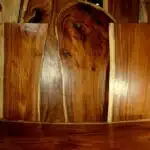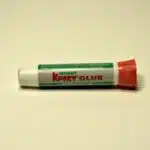Stickers can be a great way to add personality and flair to wooden objects, but removing them can be a difficult task. Whether you’re trying to remove a stubborn price tag from a wooden picture frame or getting rid of an outdated bumper sticker from your coffee table, it’s important to know how to do it without damaging the wood underneath. In this article, we will explore three effective methods for removing stickers from wood.
The first method involves using heat to loosen the adhesive, making it easier to peel off the sticker without leaving any residue behind. The second method uses oil or vinegar to dissolve the adhesive, allowing you to wipe away the sticker with ease. Finally, we’ll discuss how sandpaper can be used to gently scrape away any remaining adhesive after using one of the previous two methods. With these techniques in your arsenal, you’ll be able to remove stickers from wood surfaces quickly and easily, without causing any damage.
Understanding The Challenges Of Removing Stickers From Wood
Removing adhesives from wood can be a daunting task, especially if the sticker has been on the surface for an extended period. If not handled carefully, you may end up damaging the wood and leaving unsightly marks. As such, it is essential to understand the challenges of removing stickers from wood to prevent damage.
One of the primary challenges of removing stickers from wood is that adhesives are designed to stick firmly onto surfaces and resist easy removal. This means that even after peeling off the top layer of the sticker, some adhesive residue may remain on the surface. Removing this residue requires a delicate touch to avoid scratching or gouging into the wood.
Another challenge is that stickers are often applied to different types of wood surfaces, including finished and unfinished woods. Each type of surface presents unique challenges when removing stickers. For instance, unfinished woods tend to absorb adhesives more readily than finished woods, making them harder to remove without causing damage.
To prevent damage when removing stickers from wood, you need to take your time and approach the task with care. Rushing through this process can lead to scratches or dents on your wooden surface. Be patient and use gentle methods that do not involve harsh chemicals or abrasives that can harm your wood’s natural finish. With proper techniques and tools, you can successfully remove stickers from your wooden surfaces without causing any damage.
With an understanding of the challenges involved in removing stickers from wood, we can now focus on preparing our wooden surfaces for sticker removal.
Preparing The Surface For Sticker Removal
As we have discussed in the previous section, removing stickers from wood can be a challenging task. However, with proper preparation and the right techniques, it is possible to remove stickers without damaging the wood surface. One of the first steps in preparing the surface for sticker removal is to determine whether sanding or scraping is the best option.
Sanding and scraping are both effective ways to remove stickers from wood, but they work better on different types of wood. Sanding works well on harder woods like oak or maple, while scraping is better suited for softer woods like pine or cedar. Sanding can also help to smooth out any rough spots left behind after sticker removal.
Before beginning the sticker removal process, it is important to gather all of the necessary supplies. You will need a scraper or sandpaper (depending on which method you choose), a heat gun (if using heat to remove the sticker), a solvent or adhesive remover, and a clean cloth. It is also recommended that you wear gloves and eye protection for safety.
In summary, preparing your wood surface before removing stickers is crucial in ensuring that you do not damage the wood itself. Choosing between sanding and scraping depends on what type of wood you’re working with. And finally, gathering all necessary supplies beforehand will make the process smoother and more efficient. Let us now move onto discussing each technique in greater detail in subsequent sections starting with Sanding vs Scraping.
Gathering The Necessary Supplies
To successfully remove stickers from wood, it is important to gather the necessary supplies beforehand. This will ensure that you have everything you need and avoid any interruptions in the removal process. Here are some items that can help make your sticker removal experience a success:
Goo Gone – This is one of the best products on the market for removing sticky residue from wood surfaces. It’s easy to use and won’t damage your wood.
Rubbing alcohol – If you’re looking for a DIY alternative, rubbing alcohol is an effective solution for stickiness removal. However, it’s important to test it on a small area first to ensure that it doesn’t cause damage or discoloration.
Plastic scraper – A plastic scraper can be used to gently scrape off any remaining adhesive after removing the sticker.
Clean cloth – To finish off the job, use a clean cloth to wipe away excess residue and leave your wood surface looking shiny and new.
By gathering these supplies ahead of time, you’ll be able to effectively remove any unwanted stickers from your wood surface with ease.
Now that you have all the necessary supplies, let’s move on to method 1: using heat to remove stickers from wood. By applying heat directly onto the sticker using a hair dryer or heat gun, you can loosen up its adhesive properties which makes it easier to peel off without damaging the underlying surface.
Method 1: Using Heat To Remove Stickers From Wood
As the saying goes, “Out with the old, in with the new!” But sometimes, those pesky old stickers just won’t budge. Don’t fret, as a DIY woodworking expert, I’ve got you covered on how to remove stickers from wood in three different ways.
Method 1 involves using heat to loosen up the adhesive and make it easier to peel off. To do this, gather your necessary supplies including a hairdryer and a plastic scraper. Hold the hairdryer about 2 inches away from the sticker and blow hot air onto it for about 30 seconds. Use the plastic scraper to gently lift one corner of the sticker and continue blowing hot air while slowly peeling it off. If there is any leftover residue, use rubbing alcohol or vinegar to wipe it clean.
If using heat isn’t an option or if you don’t have a hairdryer available, don’t worry! There are alternative methods that can be just as effective. One way is to use cooking oil or peanut butter by applying a small amount onto the sticker and letting it sit for several minutes before wiping it off with a clean cloth. Another method is using a mixture of baking soda and water to create a paste that can be applied onto the sticker before being wiped away.
While method 1 may seem simple enough, let me guide you through step-by-step on how to effectively use heat to remove stickers from wood without causing any damage.
Step-By-Step Guide For Method 1
Gathering the necessary supplies for removing stickers from wood requires a scraper, heat gun, and a chemical remover. The wood should be prepped by cleaning it with a damp cloth and allowing it to dry. Applying a chemical remover is the best method for removing stickers from wood, and should be done by gently rubbing it over the sticker and allowing it to set for a few minutes. The remover should then be scraped off with a scraper and the surface should be wiped clean with a damp cloth. A heat gun can be used to loosen the adhesive on the sticker, and the sticker should then be scraped off with a scraper. Finally, the wood should be wiped clean with a damp cloth.
Gather Supplies
Removing stickers from wood can be a tedious task, but with the right supplies and techniques, it can be done easily. Before starting the process, it’s important to gather all necessary items. Choosing the right solvent is crucial in successfully removing stickers without damaging the wood. It’s recommended to use solvents such as rubbing alcohol or vinegar, as they are safe on most types of wood and do not contain harsh chemicals.
Safety precautions should also be taken when removing stickers from wood. Always wear gloves to protect your hands from any potential hazards that may arise during the process. Additionally, make sure to work in a well-ventilated area and avoid using solvents near open flames or smoke sources.
In conclusion, gathering appropriate supplies and taking necessary precautions are vital first steps in effectively removing stickers from wood. With a little effort and patience, you can restore your wooden surfaces back to their original state without causing any damage or harm.
Prepare The Wood
Preparing the wood is an essential step in removing stickers, as it ensures that the surface is clean and smooth. Before starting, make sure to remove any dirt or debris from the wood using a soft-bristled brush or a vacuum cleaner. Next, use sanding techniques to remove any rough spots or bumps on the surface of the wood. You can also use surface preparation methods such as washing with soap and water or wiping down with a damp cloth to ensure that the wood is free of any residue.
When preparing the wood for sticker removal, it’s important to consider the type of wood you’re working with. Different types of wood may require different techniques and tools. For example, hardwoods like oak or maple may need more aggressive sanding than softwoods like pine or cedar. Additionally, if you’re working with antique or valuable pieces, it’s recommended to consult a professional before proceeding with any removal techniques.
Overall, taking the time to properly prepare your wooden surfaces before removing stickers will ensure that you achieve the best possible results without causing damage. By using appropriate sanding techniques and surface preparation methods, you can restore your wooden surfaces back to their original state and enjoy their beauty for years to come.
Apply Remover
Now that we have discussed the importance of preparing the wood before removing stickers, let’s move on to the next step: applying solvents. Solvents are an effective way to dissolve adhesive residue and make sticker removal easier. There are many types of solvents available in the market, such as mineral spirits, acetone, or rubbing alcohol. It’s important to choose a solvent that is appropriate for the type of wood you’re working with and to follow the manufacturer’s instructions carefully.
To apply the solvent, use a clean cloth or brush and gently dab it onto the sticker or adhesive residue. Make sure not to saturate the wood with too much solvent as it can damage its surface or finish. After applying the solvent, give it time to work its way into the adhesive for a few minutes. You may notice that the adhesive begins to soften and loosen up.
Once you’ve allowed enough time for the solvent to work, use a scraper tool or putty knife to gently scrape off the sticker or residue. Be careful not to scratch or damage the wood surface while scraping. If there are any remaining bits of adhesive left behind, repeat this process until all traces have been removed. By following these steps carefully, you can effectively remove stickers from your wooden surfaces without causing any harm.
Tips And Tricks For Method 1
When it comes to removing stickers from wood, using heat is one of the most effective methods. One way to do this is by using a hairdryer. Simply aim the hairdryer at the sticker and apply heat until it starts to loosen up. Once the adhesive begins to melt, you can use a plastic scraper or credit card to remove it from the surface.
However, if you don’t have a hairdryer on hand, there are alternative heat sources you can use. For instance, placing a hot towel over the sticker can also help loosen up the adhesive. You could also try using a hot water bottle or even an iron (on low heat) for larger stickers. Just be sure that you’re applying heat safely and avoiding any potential damage to the wood surface.
It’s important to note that when applying heat, you should always do so with caution. Be sure not to hold your heat source too close to the wood surface as this could cause burns or other damage. Additionally, avoid leaving your heating element in one spot for too long as this could also cause damage. With these precautions in mind, using heat is an excellent way to remove stickers from wood quickly and easily. In the next section, we’ll explore another method for removing stubborn stickers: using oil or vinegar.
Method 2: Using Oil Or Vinegar To Remove Stickers From Wood
Using natural remedies for sticker removal is an excellent alternative to commercial products. Vinegar is one of the most versatile natural cleaning agents, and it can be used for removing stickers from wood surfaces. The acetic acid in vinegar breaks down the adhesive properties of the sticker, making it easy to peel off.
One of the benefits of using natural remedies like vinegar is that they are safe for both the environment and your health. Unlike commercial products that contain harmful chemicals, vinegar is non-toxic and biodegradable. It also leaves a fresh scent that will help eliminate any unpleasant odors.
To use vinegar for sticker removal, you will need a spray bottle or a clean cloth. Pour some vinegar into the spray bottle and apply it onto the sticker. Let it sit for a few minutes before attempting to peel off the sticker. If needed, use a scraper or a credit card to assist with peeling off the sticker. Repeat this process until all stickers are removed.
Transition: Now that you know about using oil or vinegar as a way to remove stickers from wood surfaces, let’s take a closer look at how to do it step-by-step using vinegar in method 2.
Step-By-Step Guide For Method 2
Next, let us dive into a step-by-step guide for Method 2. Firstly, gather the necessary materials: a hairdryer, rubbing alcohol, and a clean cloth. Begin by heating the sticker with the hairdryer on low heat for a few minutes until it becomes warm to the touch. This will loosen the adhesive and make it easier to remove.
Once the sticker is warm, use your fingernails or a plastic scraper to gently peel off as much of the sticker as possible. If any residue remains, apply some rubbing alcohol to a clean cloth and rub it onto the affected area. The alcohol will dissolve the remaining adhesive and allow you to wipe it away easily.
Tips and techniques for Method 2 include being patient and not using excessive force when removing the sticker. It is also important to test a small inconspicuous area first before applying rubbing alcohol to ensure that it does not damage or discolor the wood. Additionally, using an old credit card or plastic spatula can help prevent scratches on delicate wooden surfaces.
Transitioning into our next section about tips and tricks for Method 2, keep in mind that there are many ways to approach this process depending on your specific situation. By following these steps carefully and utilizing some of these helpful techniques, you can successfully remove stickers from wood without causing damage or leaving behind any residue.
Tips And Tricks For Method 2
One of the most common methods to remove stickers from wood is by using heat. This involves using a hairdryer or heat gun on low heat to soften the adhesive and then carefully peeling off the sticker. However, this method may not always work for every type of sticker or wood surface. In such cases, an alternative solution is to use rubbing alcohol.
Rubbing alcohol has been proven effective in removing sticky residues from various surfaces, including wood. To use this method, dip a cotton ball or cloth into rubbing alcohol and apply it directly onto the sticker. Let it sit for a few minutes to pre-soak, then gently rub away the sticker with a soft-bristled brush or scraper. Repeat as necessary until all residue is gone.
For those looking for more tips and tricks, here are three additional ways to remove stickers from wood:
- Use vinegar: Soak a cloth in white vinegar and place it over the sticker. Leave it overnight to pre-soak, then scrape away the sticker in the morning.
- Try peanut butter: Apply a generous amount of peanut butter onto the sticker and let it sit for an hour. The oil in peanut butter will help break down the adhesive, making it easier to remove.
- Use baking soda: Mix baking soda with water to create a paste and apply it onto the sticker. Let it sit for 15 minutes before wiping away with a damp cloth.
While these alternative solutions may not be as commonly used as heating or rubbing alcohol methods, they can be just as effective when dealing with stubborn stickers on wood surfaces. In the next section, we will discuss another method that utilizes sandpaper to remove stickers from wood surfaces without causing damage or scratches on your furniture or flooring.
Method 3: Using Sandpaper To Remove Stickers From Wood
Using sandpaper for sticker removal is a reliable solution to get rid of stubborn stickers from wood surfaces. However, one must be cautious not to scratch the surface while doing so. Sandpaper comes in various grits, and it’s crucial to choose the right grit for the job.
Start by using a low-grit sandpaper, such as 120 or 150 grit. Rub it gently over the sticker in circular motions until it starts to peel off. If you’re working on a delicate surface, use finer-grit sandpapers like 220 or 320 grit. Keep rubbing until all the sticker residue is gone.
Avoid pressing too hard, as this may damage the wood surface and leave visible scratches. Additionally, make sure that you only remove the sticker residue without removing any paint or finish from the wood surface. Once done, wipe down with a damp cloth and let dry before applying any finishing products.
With these tips in mind, using sandpaper for sticker removal will become much more manageable. In the next section, we’ll provide a step-by-step guide on how to use sandpaper correctly for optimal results.
Step-By-Step Guide For Method 3
- To remove stickers from wood using Method 3, the necessary supplies are a damp cloth, a plastic putty knife, and a cleaning solution.
- Start by wetting the sticker with the damp cloth, then allow a few minutes for the sticker to soften.
- Using the plastic putty knife, carefully scrape the sticker off the wood surface.
- To ensure no sticker residue remains, use the cleaning solution to wipe the wood surface.
- Repeat the process until the surface of the wood is smooth and clean.
- To prevent any damage to the wood, always use a plastic putty knife when scraping the sticker off.
Gather Supplies
To begin the process of removing stickers from wood using method three, it is essential to gather the necessary supplies beforehand. Choosing appropriate solvents is a crucial step in this process. It would be wise to find solvents that are not too harsh and won’t damage the wood’s surface. Some appropriate options for removing stickers from wood include rubbing alcohol, vinegar, and olive oil. One can also use mineral spirits or turpentine if the sticker residue is stubborn.
If you prefer finding alternatives to traditional methods, there are a few options available as well. Firstly, one can use a hairdryer to heat up the sticker residue and then gently scrape it off with a plastic scraper. Another option is to rub the adhesive residue with peanut butter and let it sit for some time before wiping it off with a clean cloth. These alternatives may take longer than traditional methods but are gentler on the wood’s surface.
In conclusion, having the right tools at hand is vital when attempting to remove stickers from wood using method three. While choosing appropriate solvents like vinegar or olive oil will make your job easier, you can always try finding alternatives like heating up the residue or using peanut butter instead of traditional methods. Remember to be patient while taking on this task; removing stickers from wood requires effort and time but will leave your furniture looking good as new once completed.
Wet The Sticker
When it comes to removing stickers from wood using method three, there are several steps to follow. One of the crucial steps is to wet the sticker first before attempting to remove it. Wetting the sticker can help loosen the adhesive, making it easier to peel off without causing damage to the wood’s surface. Additionally, soaking the sticker can also prevent it from tearing or leaving behind residue.
There are several benefits of soaking a sticker before removal. Firstly, it reduces the risk of damaging the wood’s surface by making it easier to remove without using excessive force. Secondly, soaking can help soften stubborn adhesives and make them more pliable for removal. Lastly, wetting a sticker can also help reduce any residual marks left behind on the wood’s surface after removal.
It’s important to remember that once you’ve wetted the sticker thoroughly, you need to let it dry before attempting to remove it. Tips for drying include gently patting down with a clean cloth or paper towel and avoiding any excessive rubbing that could cause damage or spread moisture around. Once dry, you can begin peeling off the sticker carefully while holding down any loose edges with one hand and pulling at a 45-degree angle with your other hand until all remnants have been removed successfully.
Scrape Sticker
Moving on to the next step in our method three guide for removing stickers from wood, we have the ‘Scrape Sticker’ subtopic. While soaking and peeling off a sticker may work for some, others may find that using solvents or scraping is necessary. This method involves using a scraper or razor blade to remove the sticker while minimizing scratches on the wood’s surface.
To begin, apply a small amount of solvent onto the sticker and let it sit for a few minutes. This will help dissolve any remaining adhesive and make it easier to scrape off. Next, take your scraper or razor blade and carefully slide it under one corner of the sticker. Use gentle pressure to lift up the corner and slowly work your way across until all remnants have been removed.
It’s important to be cautious while scraping as you don’t want to damage or scratch the wood’s surface. Always use light pressure and keep your scraper at an angle to minimize any potential damage. Additionally, make sure to clean up any remaining solvent with a clean cloth or paper towel once you’ve finished scraping. With these steps, you can effectively remove stickers from wood using method three without causing harm to its surface.
Tips And Tricks For Method 3
After following the step-by-step guide for method 3, you may have successfully removed the stubborn stickers from your wooden surface. However, it is important to note that not all stickers are created equal and some may require a bit more effort or different techniques. It is also crucial to consider post-removal care for your wooden surface.
Using solvents can be an effective way to remove stickers from wood, but it is important to exercise caution. Make sure to read and follow all instructions on the solvent carefully and wear protective gloves and eyewear. Test a small, inconspicuous area of the wood first before applying the solvent to the sticker. Apply a small amount of solvent with a cotton swab or cloth and gently rub the sticker until it begins to loosen. Once removed, wipe away any excess solvent with a clean cloth.
Preventing damage to your wooden surface during sticker removal should be a top priority. Avoid using sharp objects such as knives or razor blades as they can scratch or gouge the wood. Instead, use plastic scrapers or credit cards to gently scrape away at the sticker. Additionally, avoid using harsh chemicals that could potentially harm or discolor the wood. Always start with gentle methods before moving on to more aggressive techniques.
Now that you have successfully removed the stickers from your wooden surface, it is important to take proper care of it moving forward. Depending on the type of wood and finish, you may need to apply polish or wax regularly to maintain its appearance and protect it from potential damage in the future. By taking proper care of your wooden surfaces, you can ensure they remain beautiful and functional for years to come without any unsightly stickers detracting from their natural beauty.
Post-Removal Care For Your Wooden Surface
After successfully removing stickers from your wooden surface, it is crucial to take care of the wood to prevent any damage. Different types of wood require different care, so it’s important to know what type of wood you’re working with. For example, softwoods like pine and cedar require more attention than hardwoods like oak and mahogany. Softwoods are more susceptible to dents and scratches, so be sure to handle them with care.
To prevent future sticker residue on your wooden surface, consider using a protective coating such as wax or varnish. This will not only protect the wood but also make it easier to remove any residue in the future. It is also recommended that you avoid placing stickers directly onto the wood, as this can cause damage and leave behind sticky residue. Instead, place them on a piece of paper or cardboard first before attaching them to the wooden surface.
In addition to applying a protective coating and avoiding direct contact with stickers, there are other steps you can take to maintain the integrity of your wooden surface. Avoid placing hot objects directly onto the wood, as this can cause discoloration and even scorch marks. It’s also important to keep your wooden surface dry at all times, as moisture can lead to warping and cracking over time. By taking these precautions and maintaining proper care for your wooden surfaces, you can enjoy their beauty and longevity for years to come.
As important as it is to remove stickers from wood properly, it’s equally important not to make common mistakes that could cause damage or leave behind residue. In the next section we’ll discuss some common mistakes people make when removing stickers from wood and how you can avoid them.
Common Mistakes To Avoid When Removing Stickers From Wood
1.When attempting to remove a sticker from wood, heating the sticker should be avoided as it can damage the wood. 2.Using a sufficient amount of an adhesive remover is also important; if the remover does not have enough contact time with the adhesive, it will not be as effective. 3.Scraping must be done carefully in order to limit any possible damage to the wood; a dull or flexible scraper should be used. 4.Using aggressive tools to scrape can damage the wood’s surface and should be avoided. 5.Sharp objects should not be used to scrape the sticker as they can create gouges in the wood surface. 6.Using too much force while scraping can also cause surface damage to the wood and should be avoided.
Not Heating Sticker
Removing stickers from wood can be a daunting task, especially if you don’t know the right techniques. One common mistake that people make is heating the sticker to remove it, which may cause damage to the wood. It’s important to avoid this mistake and use other effective methods for removing stickers without causing harm.
Using solvents is one of the most effective ways to remove stickers from wood without causing any damage. You can apply solvents such as rubbing alcohol or acetone directly on the sticker and let it sit for a few minutes before gently scraping it off with a plastic scraper. This method works best for non-porous surfaces like varnished or painted woods.
Scraping gently is another effective way to remove stickers from wood without damaging it. You can use a plastic scraper or credit card to scrape off the sticker slowly and gently until it comes off completely. Be careful not to scratch or gouge the wood surface while scraping. With these simple techniques, you can easily remove stickers from wood without damaging its natural beauty and elegance.
Not Using Enough Adhesive Remover
When it comes to removing stickers from wood, people often make mistakes that can cause damage to the surface. One common mistake is not using enough adhesive remover. Adhesive removers are highly effective in dissolving the glue and making it easier to remove the sticker. However, if you don’t use enough of it, the sticker may not come off completely, and you might end up damaging the wood surface while trying to scrape it off.
To use adhesive remover effectively, apply a generous amount of it on the sticker and let it sit for a few minutes. The longer you let it sit, the easier it will be to remove the sticker without damaging the wood surface. You can then use a plastic scraper or credit card to gently scrape off the sticker. If some residue remains, repeat the process until all traces of glue are gone.
Avoiding damage to the wood surface is crucial when removing stickers. It’s important to take your time and work slowly and carefully so that you don’t scratch or gouge the surface while scraping off the sticker. Using adhesive remover effectively is one way to prevent damage as it softens the glue and makes it easier to remove without having to exert too much force. With patience and these tips, you can easily remove stickers from wood without causing any harm.
Not Scraping Carefully
When it comes to removing stickers from wood, there are common mistakes that people often make. One of these is not scraping carefully, which can lead to surface damage. Proper scraping techniques are essential in avoiding this.
When removing a sticker from wood, you must use the right tools and techniques. Using a scraper that is too sharp or applying too much pressure can cause scratches or gouges on the surface. To avoid this, use a plastic scraper or credit card and work slowly and carefully. Start at one corner of the sticker and gently lift it up, being careful not to scratch the surface.
It’s also important to avoid excess force when scraping off the sticker as this can cause damage to the wood surface. If you encounter resistance while removing the sticker, apply more adhesive remover and let it sit for a few minutes before attempting again. With proper scraping techniques and patience, you can remove stickers from wood without causing any harm to its surface.
Conclusion: Choosing The Best Method For Your Needs
Choosing the Best Method for Your Needs
Choosing the right method to remove stickers from wood can be a bit tricky. Each method has its own pros and cons, and it is important to consider these factors before deciding which one to use. The first method, using heat, is great for removing stubborn stickers that have been on the wood for a long time. However, this method requires a lot of patience as it takes time for the heat to soften the adhesive.
Another method is using an oil-based solvent such as WD-40 or Goo Gone. This method is quick and easy since you just need to apply the solvent on the sticker and let it sit for a few minutes before wiping it off. However, this method may not work well on certain types of wood finishes as it could damage them.
The third method involves using natural solvents such as vinegar or baking soda mixed with water. This method is safe and environmentally friendly, but may require multiple applications depending on how strong the adhesive is. Ultimately, choosing the best method depends on your needs – if you want something quick and easy, then an oil-based solvent may be your best bet. If you prefer natural methods or are worried about damaging your wood finish, then using a natural solvent may be more suitable for you.
By weighing out the pros and cons of each method, you can make an informed decision on which one would work best for your situation. Keep in mind that some methods may take longer than others or require more effort, but ultimately, all three methods are effective ways to remove stickers from wood without causing any damage.
Conclusion
Removing stickers from wood can be a challenging task, but it is not impossible. It requires patience, the right tools and techniques, and some basic knowledge about the type of wood surface you are working with. As a DIY woodworking expert, I have tried various methods to remove stickers from wooden surfaces and found three effective ways that work best.
Firstly, using heat to remove stickers from wood is an easy and effective method. Secondly, using commercial adhesive removers or solvents can also be helpful. Lastly, vinegar and oil mixture can also do the trick. It is important to note that each method has its own pros and cons, so it’s essential to choose the one that best suits your needs.
Did you know that according to a recent survey by Adhesive & Sealant Council, adhesives play a vital role in over 80% of all manufactured goods? The use of adhesive on products such as stickers makes them difficult to remove without damaging the surface underneath. However, with these three methods outlined above, you can safely and effectively remove stickers from your wooden surfaces without causing any harm.
In conclusion, removing stickers from wood requires careful consideration of the type of wood surface and choosing the right method for removal. By following these steps outlined in this article and avoiding common mistakes, you can restore your wooden surface back to its original beauty in no time!
Image Credits
- “Laughing Squid Stickers” by Scott Beale (featured)












![How To Repair Rotted Wood 12 Texture : Altario Buick Estate Wagon : Rotting Faux Wood Paneling [1 of 2]](https://green-life.blog/wp-content/uploads/2023/05/z1CersK-gCjq-150x150.jpg.webp)
















